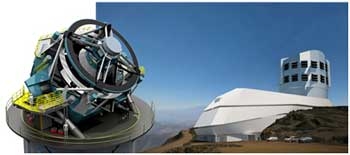National Science Board authorizes LSST preliminary design review
 (Download Image)
LSST rendering (left) and summit facility design (right).
(Download Image)
LSST rendering (left) and summit facility design (right).
The National Science Board has given permission for the Division of Astronomical Sciences at the National Science Foundation (NSF) to conduct a preliminary design review for the Large Synoptic Survey Telescope (LSST).
Livermore has played a pivotal role in the LSST project over the last decade, including: development of the overall optical design, leadership in the development of the operations simulator (which calculates how the telescope can be optimally scheduled for multiple scientific programs), design of the wavefront sensing and guide sensor systems (which measure the aberrations in the telescope optics and the errors in pointing, so that these can be corrected by the telescope active optics and guiding systems) and design of the camera optics and filters (drawing on expertise from the National Ignition Facility's large optics development). Livermore researchers also have led work to understand how well LSST will be able to estimate cosmological parameters using observations of supernovae.
The authorization of a design review followed the recommendation of a committee convened by the National Research Council for the National Academy of Sciences. The committee issued a report last August, "New Worlds and New Horizons in Astronomy and Astrophysics," that ranked LSST as its top priority for the next large ground-based astronomical facility and recommended that LSST be submitted for consideration to the NSF's Major Research Equipment and Facilities Construction (MREFC) program with the goal of achieving first light before the end of the decade.
The National Science Board has now authorized the NSF to review the LSST design, which is the next step toward funding the construction of the facility.
Scheduled to begin full survey operations six years after the construction begins, the 8.4-tmeter LSST telescope will be equipped with the world's largest digital camera (3.2 billion pixels). This system will survey the entire visible sky to very faint limits in multiple colors every week. The survey will last for 10 years and will produce 2,000 images of every part of the sky more than 20,000 square degrees. It will be constructed on Cerro Pachon, a mountain in northern Chile.
LSST will produce 30 terabytes of data per night, yielding a total database of 100 petabytes. This massive data set will be used to construct, for the first time, a color "movie" of the sky that will enable unique and powerful studies of objects that move or change in brightness. Examples range from potentially hazardous near-Earth asteroids to exploding massive stars in the distant Universe. The total ten-year data set also will use the light-bending gravity of dark matter to chart the history of the expansion of the universe and probe the mysterious nature of dark energy.
Thirty-four universities and national labs, including Lawrence Livermore, have joined together in a public-private partnership to build LSST. The National Science Foundation and the Department of Energy Office of Science have contributed funds for design and development. Significant private support has come from Charles Simonyi and from Bill Gates, who has called LSST "the ultimate network peripheral device to explore the Universe."
For more information about the LSST including current images, graphics, and animation, go to the LSST Website.
Contact
Anne M Stark[email protected]
925-422-9799
Tags
Rubin ObservatoryPhysical and Life Sciences
Featured Articles







